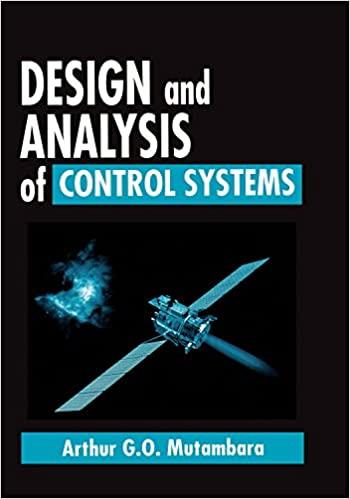Design Project: The closed-loop control system of the DC motor can be derived and shown to be
Question:
Design Project:
The closed-loop control system of the DC motor can be derived and shown to be given by Pigure 4. 32. The terms S1( s), 0,. ( s) are the Laplace transforms of the actual angular speed w( t) and the desir-ed angular speed w,. ( t), respectively. E(s) and U(s) are the Laplace transforms of the error and the control signals.
Or(s) +0 E(s)_[ D(s) [ U(s) Rb+K2 Q(s)
. . (JL)s 2 +(Lb+RJ)s+Rb+K2 I
-r'---------------'1 FIGURE 4.32 Closed-Loop Motor Speed Control (PID)
The cont·roller D( s) can take the form of any one of the four controlleTS P, PI, P D, and PI D. A PI D controllcT contains all three control components
(proportional, derivative, and integral) and hence, its transfer fnnction can be represented as follows K
D(s) "= Kp + - 1 + Kn,s s Kns 2 + Kps + Kr s
Thns, the corresponding block diagram representation takes the form shown in Figure 4. 33. This is the generic PI D controller, and the other controllers P, PI, P D can be modeled in a similaT fashion.
E(s) D(s) U(s) .. E(s)
FIGURE 4.33 A PID Controller: Block Diagram Form
(a) Characteristics of P ID Controllers I U(s) By employing ]i,fATLAB, implenu·nt fonr closed-Loop control systems for the DC motor by using the four controllers (P, PI, P D, and PI D) and the data provided. The objective is to satisfy the given design reqnirements.From the results discuss the benefits and drawbacks of the controller components; Pmporl.ional (P), Integral (1), and Derivative (D). Also show and explain how the three components compensate for each other's drawbacks. (b) Tuning of PID Controllers: From the MATLAB implementation explain how you choose the gains (Kp, Kr Kn) for the controllers (P, PI, PD and PID)? DATA Assume the following values for the physical parameters, which were derived by experiment from an actual motor: Moment of inertia of the rotor J = 0.012kg.m2 Damping ratio of the mechanical system b = 0.105Nms Electromotive force constant K = O.OlNm/Amp Electric resistance R = lfl Electric inductance L O.G05H DESIGN R£QUIREMENTS: Desired angular speed wr(t) = lrad/ sec Settling time t 8 = lsec, Overshoot l\1P ~ 20%, Steady slate error e88 (t) ~ Problem
Step by Step Answer:

Design And Analysis Of Control Systems
ISBN: 9780199577309
1st Edition
Authors: Arthur G O Mutambara






